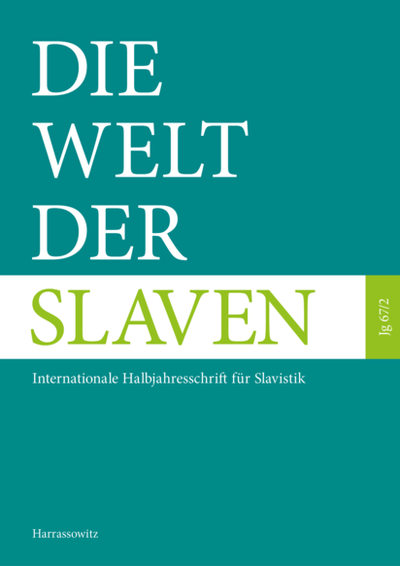Middle-Polish constructions of comparison of inequality
DOI:
https://doi.org/10.13173/WS.67.2.352Schlagwörter:
Middle Polish, syntax, comparative constructions, corpus linguisticsAbstract
In Middle Polish there were several comparative markers (niż, nad, od, jako and jak). Although replacing one marker with another had no consequences for the interpretation of an utterance, it seems unlikely that in any given language there should be fully interchangeable elements. This paper intends to answer the question what governed the choice of comparative marker. This problem has already been addressed both synchronically and diachronically (inter alia by, Greszczuk 1988, Kallas 1997a, and Bondaruk 1998); however, an examination of the data retrieved from a machine-readable corpus (the KorBa corpus) allows to reveal previously overlooked facts. The distribution of the markers is not random, though it is governed by tendencies rather than rules. We examine the role of such factors as part of speech of the feature compared (adjective vs adverb), part of speech of the comparans (noun vs pronoun), meaning of the compared feature, and text type.
Literaturhinweise
Bendixen, Mike. 1996. A practical guide to the use of correspondence analysis in marketing research. Marketing Research On-Line 1(1). 16–36.
Bondaruk, Anna. 1998. Comparison in English and Polish adjectives: A syntactic study. Lublin.
Boryś, Wiesław. 2010. Słownik etymologiczny języka polskiego. Kraków.
Bronikowska, Renata & Gruszczyński, Włodzimierz & Ogrodniczuk, Maciej & Woliński, Marcin. 2016. The use of electronic historical dictionary data in corpus design. Studies in Polish Linguistics 11(2). 47–56.
Chen, Weirong. 2020. Comparative constructions of inequality. In idem, A Grammar of Southern Min: The Hui’an Dialect, 311–336. Berlin.
Długosz-Kurczabowa, Krystyna. 2009. Lepszy niż… i lepszy od… Poradnia językowa PWN. https://sjp.pwn.pl/poradnia/haslo/;10270.html (retrieved 17 Jan 2022).
Hankamer, Jorge. 1973. Why there are two than’s in English? In Corum, Claudia et al. (eds.), Papers from the Ninth Regional Meeting of the Chicago Linguistic Society, 179–191. Chicago.
Goldberg, Adele E. 2006. Constructions at work: The nature of generalization in language. Oxford.
Greszczuk, Barbara. 1981. Z historii konstrukcji z jako, jakoż, itp. Język Polski 61. 42–53.
Greszczuk, Barbara. 1985. Syntaktyczne sposoby realizacji porównań w polszczyźnie współczesnej. Rocznik Naukowo-Dydaktyczny Wyższej Szkoły Pedagogicznej w Rzeszowie: Filologia Polska 60. 53–79.
Greszczuk, Barbara. 1986. Synonimia syntaktycznych konstrukcji porównawczych. In Preyzner, Marcin (ed.), Język – teoria – dydaktyka: Materiały VII konferencji młodych językoznawców, 263–274. Kielce.
Greszczuk, Barbara. 1988. Konstrukcje porównawcze i ich rozwój w języku polskim. Rzeszów.
Kallas, Krystyna. 1995. O konstrukcjach z przyimkiem niż. In Grochowski, Maciej (ed.), Wyrażenia funkcyjne w systemie i tekście, 99–110. Toruń.
Kallas, Krystyna. 1997a. Składnia zdań porównawczych: Uwagi o zdaniach zespolonych spójnikiem niż. Polonica 18. 11–27.
Kallas, Krystyna. 1997b. Rola czynników semantycznych w strukturze polskich konstrukcji porównawczych (z konektorem niż). Biuletyn Polskiego Towarzystwa Językoznawczego 52. 135–145.
Kallas, Krystyna. 1998a. On Polish syntactic constructions with the conjunction niż ‘than’. In Grochowski, Maciej & Hentschel, Gerd (eds.), Funktionswörter im Polnischen, 195–218. Oldenburg.
Kallas, Krystyna. 2006. Kategoria słowotwórcza podobieństwa we współczesnym języku polskim. In Bobrowski, Ireneusz & Kowalik, Krystyna (eds.), Od fonemu do tekstu: Prace dedykowane prof. Romanowi Laskowskiemu, 239–247. Kraków.
Nitsch, Kazimierz & Ostrowska, Ewa. 1952. Zakres używania jak i niż. Język Polski 32. 215–223.
Post, Michał. 1982. Preliminaries to the study of comparative words in English and Polish. Papers and Studies in Contrastive Linguistics 14. 59–70.
Stassen, Leon. 1985. Comparison and Universal Grammar. Oxford.
Stassen, Leon. 2013. Comparative Constructions. In Dryer, Matthew S. & Haspelmath, Martin (eds.), The World Atlas of Language Structures online. http://wals.info/chapter/121 (accessed 1 Feb 2022).
Szober, Stanisław. 1962. Gramatyka języka polskiego. Warszawa.
Szupryczyńska, Maria. 1979. Związki składniowe form stopnia wyższego polskiego przymiotnika. Polonica 5. 115–137.
Twardzik, Wacław (ed.). 2006. Biblioteka zabytków polskiego piśmiennictwa średniowiecznego. https://ijp.pan.pl/wp-content/uploads/2018/10/BZ.pdf (accessed 22 Feb 2022).
Wierzbicka, Anna. 1988. The semantics of grammar. Amsterdam.
Wołoszyk-Pisarska, Alicja. 1976. Basic characteristics of comparative constructions in English and Polish. Papers and Studies in Contrastive Linguistics 4. 153–165.

